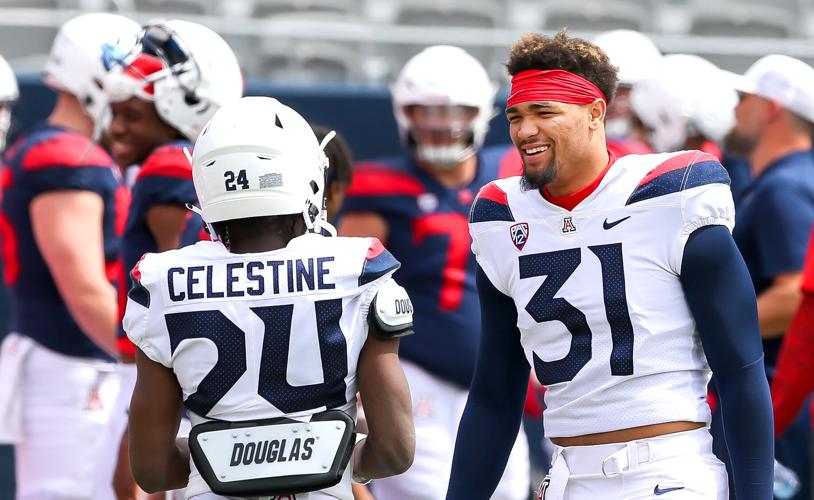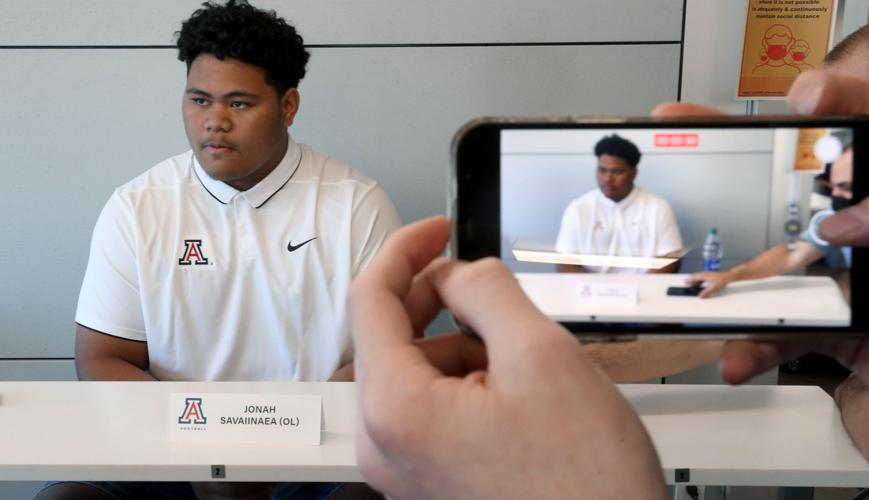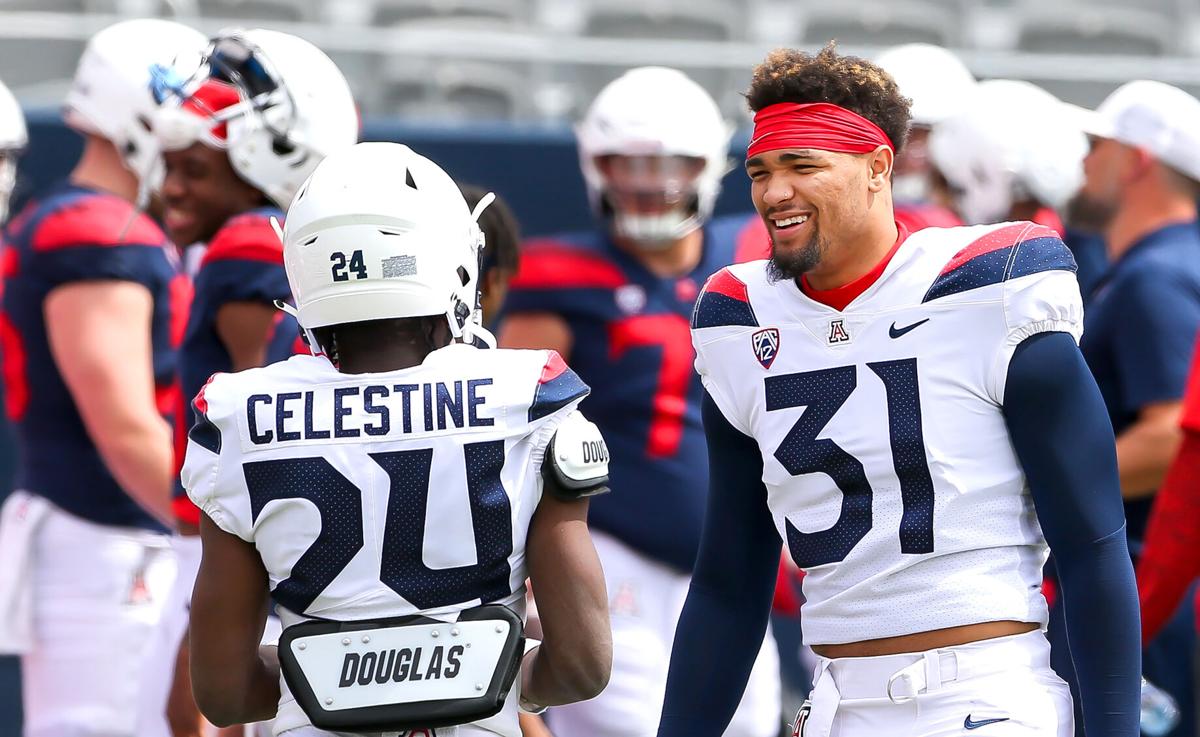It’s the hardest aspect to judge. It’s also the most critical element of the sport.
We watched almost every snap of Arizona’s 15 spring practices. We can’t say definitively that the Wildcats have made major strides in the areas that matter the most — the offensive and defensive fronts.
There’s plenty of cause for optimism. There are also reasons to be skeptical.
The upgrades Arizona has made at other positions have raised expectations for a team that went 1-11 last season. Line play ultimately will determine how far the Wildcats can go.
That’s the topic we’ll explore in the third and final part of our UA spring-ball rewind.
Lingering question No. 3: How much has Arizona improved up front, and how will that affect the Wildcats’ prospects in 2022?
Let’s start with an observation: Neither side dominated the other during spring ball. Last spring it felt as if the defensive front got the better of the offensive line almost every day. If we had to give an edge this year, we’d give it to the defense. But it was more of a split decision than a knockout.
The most noticeable player in the defensive front was newcomer Hunter Echols. After a slow start, the transfer from USC made plays regularly from the “Cat” position — a hybrid defensive end/linebacker spot. Echols rushed the passer on most plays and got home often. He also knocked down several passes.
Echols came to Arizona to reunite with Johnny Nansen, a former USC assistant who’s now the Wildcats’ defensive coordinator, and to improve his stock for the 2023 NFL draft. Nansen will put Echols in a position to make plays. It’s up to him to take advantage of those opportunities. The former four-star recruit had only 1.5 sacks in four seasons at USC.
Echols’ bookend, Jalen Harris, decided to come back for a sixth season. He’s coming off his most product campaign (career-high 47 tackles, 3.5 sacks, four passes defensed) and has transformed his body during his UA tenure. But Harris still hasn’t had that breakout season in the sack department.
Harris’ younger brother, Jason, is a player to keep an eye on. A former four-star recruit, Jason Harris didn’t play last season after transferring from Colorado. He was one of Arizona’s most improved players this spring and offers oodles of potential at 6-7, 252. Whether he starts to realize it this season remains to be seen.
Inside, Arizona has the makings of a strong rotation. A lot will depend on the health of Kyon Barrs, who missed all of spring practice after undergoing foot surgery. Barrs was arguably the Wildcats’ best player last season. His health will be a major storyline come August.
When Arizona landed Tiaoalii Savea from UCLA via the transfer portal, he seemed like a shoo-in to start alongside Barrs. Returnee Paris Shand had other ideas. Shand, a third-year sophomore who started three games last season, ran with the ones throughout spring. The former basketball player offers intriguing upside with his size (6-5, 276) and athleticism.
If Savea and Dion Wilson Jr. — who are both 6-4 and 290-plus pounds — are your backup defensive tackles, that’s not a bad place to be. JB Brown played inside and outside during spring and provides Nansen with another versatile, veteran presence.
The linebacking corps offers more questions than answers. Jerry Roberts, the projected starter in the middle, was in and out of the lineup during spring while recovering from a broken leg suffered in November. Malik Reed, who played both “Mike” and “Will” during spring, also battled injuries. Newcomer Anthony Solomon has a similar profile to Echols — former four-start recruit who hasn’t produced to that level in college. Can Nansen and his staff turn that potential into production?
Nansen specializes in defensive-front play and coaches the linebackers. He came to Arizona from UCLA, where he was the defensive line coach the past two seasons. The Bruins ranked second in the Pac-12 in run defense last season. The previous year, they allowed the lowest average per carry in the league and had the most sacks per game. That’s promising.
On the other side of the line, the Wildcats didn’t make massive personnel changes — a development that set off alarm bells within the fanbase. Impact offensive linemen are a rare commodity, even in the overflowing transfer portal, and Arizona wasn’t able to land any offensive linemen from four-year schools who are eligible this season.
Brennan Carroll, the Wildcats’ offensive coordinator and O-line coach, is banking on several other factors to boost Arizona’s blocking.
One is experience and continuity. Returning starters Josh Donovan, Paiton Fears and Jordan Morgan, among others, have had a full year in Jedd Fisch’s system. They know what Carroll wants out of them. That should benefit the group.
Another factor is improved QB play. How many of the 35 sacks Arizona surrendered last year were the result of quarterbacks holding the ball too long? Opposing defensive fronts also could afford to be more aggressive without the consistent threat of a downfield passing game. The arrival of Jayden de Laura and several new receiving weapons should alleviate some of the strain the offensive line faced.

Offensive lineman Jonah Savaiinea could make an instant impact as a freshman.
Arizona did add a big-time talent up front in guard Jonah Savaiinaea. It’s a lot to ask of a true freshman to step in and start, but Savaiinaea embraced the challenge in spring. He has the potential to be a people mover at 6-3, 337 pounds.
Projected starting center Josh Baker missed spring practice because of a pectoral injury, but that could benefit the Wildcats in the long run (assuming Baker is able to return at full strength). His absence gave second-year player JT Hand a chance to take most of the first-team reps. He’ll grow from that experience.
Building depth along the offensive line is an ongoing project. Baylor transfer Davis DiVall, who sat out last season, participated in the latter portion of spring practice after an unexplained absence and could push for playing time at guard. JC transfer Joseph Borjon has prototype size at 6-7, 339, but could be a year away. Freshman tackle Jacob Reece’s football future is uncertain after his UA physical revealed a heart condition.
Arizona is believed to have one scholarship available for the 2022 cycle. If the Wildcats use it, it’ll likely go to a lineman (offensive or defensive) or linebacker. Even after the expected surge in portal entries following spring football, it’s hard to imagine Arizona adding a player who’d greatly impact its fortunes.
ESPN’s Football Power Index projects the Wildcats’ win total at 3.5; the Vegas over/under might land there as well.
A three-or four-win season would signify improvement over last year. It would be a clear step in the right direction.
Is Arizona capable of even more? Maybe. You can’t help but like the upgrades at quarterback and receiver. The running back room is deep and talented. The secondary could be among the Pac-12’s best. The specialists should be as well.
The Wildcats’ play up front will tell the tale. It’s a story that’s still being written.






